This leaflet answers common questions about soft tissue shoulder injuries. If you would like further information, or have any worries, please do not hesitate to ask your nearest clinician.

What is a soft tissue shoulder injury?
This is a sprain to your shoulder.
Healing
It normally takes six weeks to heal, but symptoms can continue for three to six months. Smoking will slow down your healing. We would advise that you stop smoking while your fracture heals. Talk to your GP for more information.
Pain and swelling
Your shoulder may be swollen, and you will have some pain. Taking pain medication and using ice or cold packs will help. More information is on the next page.
Wearing your sling
Your sling can be worn for comfort. You can take it off to wash, dress and do your exercises.
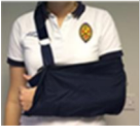
Exercise and activity
It is important to start gentle exercises straight away to prevent stiffness. You will find pictures and instructions for your exercises below. Start with stage one exercises. As soon as you feel ready you can progress to the next stages.
Follow-up
We are expecting your injury to get better with time and this care plan. However, if you have significant pain or do not achieve full movement six weeks after your injury then please contact us.
Stage one exercises
Hand, wrist, and elbow exercises are only needed while you are wearing a sling. You can stop these once they become easy, and you have full movement. Try to do these exercises four to five times a day. Repeat each exercise 10 times.
Hand, wrist, and elbow exercises

Open and close your hand. Next, move your wrist up and down. Repeat 10 times.
After a few days, hold a soft ball or rolled up socks. Squeeze the ball and hold for five seconds. Repeat five times.
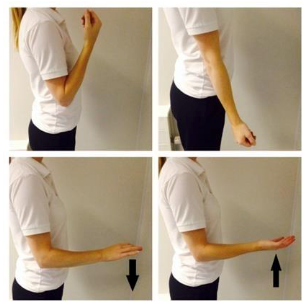
Bend and straighten your elbow. Repeat 10 times.
Bend your elbow to a right angle. Slowly turn your palm up to the ceiling and down to the ground. Repeat 10 times.
Posture exercise
Bring your shoulders back and gently squeeze your shoulder blades together. Hold for 20-30 seconds.
Repeat five times.

Shoulder pendulum exercise
Stand next to a firm surface. Support yourself with your un-injured arm and lean forwards. Let your injured arm relax and hang down to the ground.
Gently swing your arm, making a small movement. Try to do this forward and backward, side to side and in small circles. Aim to do this for one to two minutes in total. You do not need to push into pain. Remember to keep your arm relaxed.
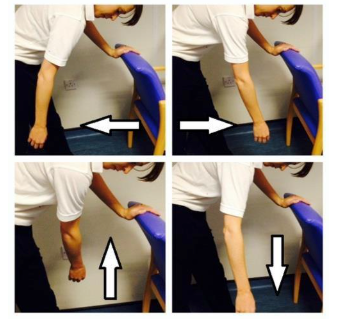
Stage 2 exercises
You can start these exercises as soon as you are able to. Try to do these exercises four to five times a day. Repeat each exercise 10 times.
Active assisted flexion
Use your other hand to lift your injured arm up in front of you.
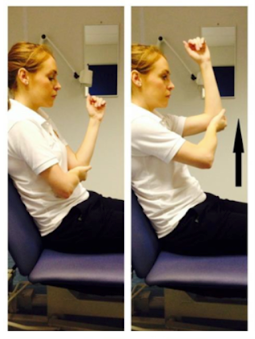
Active assisted external rotation
Keep the elbow of your injured arm tucked into your side and your elbow bent. Hold onto a stick, umbrella, or something similar. Use your good arm to push your injured hand outwards. Remember to keep your elbow tucked in.
If you don’t have a stick, hold your injured arm at the wrist, guide it with your good hand.
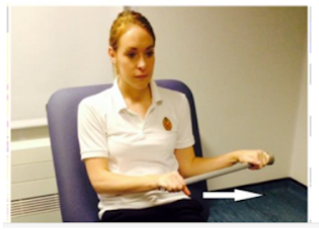
Stage 3 exercises
You can start these exercises as soon as you are able to do stage two exercises comfortably. Try to do these exercises 4-5 times a day. Repeat each exercise 10 times.
Active Flexion
Lift your arm forwards in front of you. Try to raise the arm as high as you can. You do not need to push into pain. If this is too difficult, try the same movement with a bent elbow.

Active abduction
With your palm facing forwards, move your arm out to the side in a big arc. Try to raise the arm as high as you can. You do not need to push into pain. If this is too difficult, try the same movement with a bent elbow.
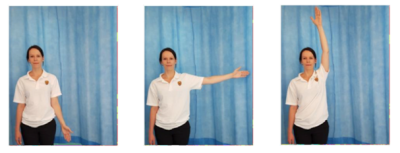
Active external rotation
Start with your elbow bent by your side. Move your forearm out to the side, keeping your elbow bent and near your waist.
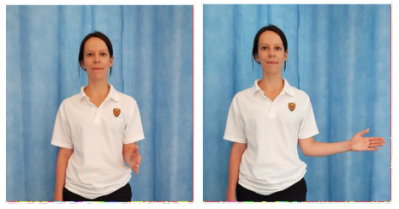
Concern about your symptoms
If you are concerned about your symptoms and/or struggling to return to exercise, please contact the virtual fracture clinic.
I am struggling with my sling. What do I do?
Contact the virtual fracture clinic. We can give advice or change your sling if needed.
Driving
You can return to driving when:
- You are no longer using a sling
- You can move comfortably and
- You can control the vehicle safely.
Please refer to the DVLA website regarding your fitness to drive if required.
Fitness for work statement
You can get a fitness for work statement from your GP or the doctor at your fracture clinic appointment.
 Translate
Translate